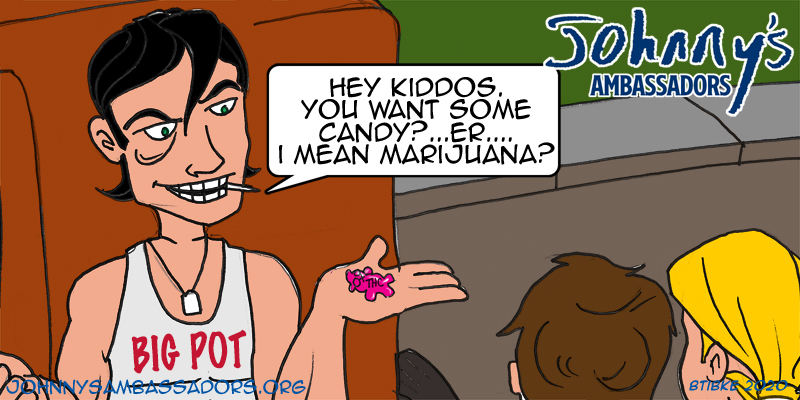By Laura Stack
According to the annual LESSONS LEARNED FROM STATE MARIJUANA LEGALIZATION report from marijuana industry watchdog Smart Approaches to Marijuana (SAM), cannabis is on its way to becoming the next Big Tobacco. In Colorado where I live, recreational use of marijuana has been legal since 2012 and widely available in 2014, when Johnny was 14 years old and started experimenting. Now in 2020, there are far more marijuana-based businesses than Starbucks and McDonalds franchises combined (1,012 to 600)—as difficult as that may be to believe.
In this 2020-2021 edition, SAM continues to track the advancing wave of marijuana legalization in the U.S., as well as the trends associated with it. One such trend is the decreasing perception of the harms of marijuana. More than 20,000 journal articles have been released thus far detailing the negative effects of marijuana, along with multitudes of reports at the state and national levels dealing with the repercussions of statewide legalization, yet nothing serious has been done to limit potency or keep it away from our children.
Marijuana and our Youth
For the 12- to 17-year-old age group, an estimated 1.1 million to 1.4 million “new initiates” first started using marijuana in the past year each year since 2002. At least new cigarette smokers know the risks; how could they not after decades of warnings? But the risks of marijuana use have yet to be widely publicized.
The situation is dire among the age group from 12-17, and it becomes worse as youths reach legal adulthood at 18. Although 21 is the legal age for drinking, smoking, and marijuana use, young people who are away from their families for the first time typically have greater access to these substances and less oversight.
As emphasized by the SAM report, users under age 21 are hit especially hard by marijuana. As we’ve discussed in previous blog articles, hard scientific evidence proves that marijuana interferes with the development of the prefrontal cortex of the brain, resulting in increased risk of schizophrenia, suicidal thought and behavior, anxiety, panic attacks, depression, paranoia, psychosis, and more. All this is more likely to occur with modern pot, which is much more potent than past varieties. Most flower marijuana on the legal market (including medical marijuana) contains more than 15% THC and up to 35%, and some concentrated marijuana products have THC potency as high as 90-95%.
Vaping is a popular method of marijuana use among young people. A concerning trend was the sudden increase in vape-related respiratory ailments, known collectively as EVALI (e-cigarette or vaping product use-associated lung injury). EVALI has claimed over 70 lives, with over 2,700 known cases in the U.S., often with life-long effects. Many of these cases seem to have been caused by contaminated THC vape solutions or by Vitamin-E thickening compounds. While the CDC recommends that users avoid vaping altogether, according to SAM, the response by the marijuana industry has been that the only way to insure non-contaminated THC solutions is to legalize and regulate it.
If someone is 21 or older and wants to take their chances as an adult who is well-informed of the consequences, they have the legal right to do so in an increasing number of states. The problem is that in states where legalization of recreational marijuana has become well established, usage rates have increased all across the board for people of all ages, so it damages our children.
For example, studies have shown that legalization of recreational marijuana use results in up to a six-fold increase in self-reported past-year marijuana use among adolescents. The prevalence of Marijuana Use Disorder (a.k.a. Cannabis Use Disorder) has increased by 25% among kids 12-17 years old since full legalization. Underage dabbing of high-potency concentrates has also shown a striking increase among teens who use; the total has climbed above 30% for kids in Oregon and Colorado. Worse, there seems to be a direct link between adolescent marijuana use and other drug use, especially later opioid abuse. Having ever used marijuana in a lifetime is the greatest predictor of current 30-day opioid use in high schoolers – even more than current 30 day alcohol use – so marijuana is the reining gateway drug.
The Bottom Line
To paraphrase the Supreme Court regarding the right of free speech in times of war, marijuana presents a “clear and present danger” to American adolescents. Unfortunately, while this test has been applied to free speech, it has not been adequately applied to legalized marijuana use at the state level. Indeed, even though marijuana remains completely illegal at a federal level, federal protections—or at least the political will to enforce them—have seemingly melted away in recent years.
The legality of recreational marijuana and its ease of access hurts our young people at a disproportionately high rate. Please don’t try to tell me, “Oh, teens can’t get a hold of it.” That is so untrue it makes me laugh aloud. Any high schooler can have weed within five minutes. The 18-year-old seniors get med cards and then sell it to the younger teens—everyone knows who their high school drug dealer is—ours was Johnny. Users also usually sell. The consumer demographic skews toward our teens, as the industry needs to addict its next generation of users.
Ironically, most of the municipalities, cities, and county in states where marijuana has been fully legalized don’t even want it to be legal, and they have banned it. In California, 80% of localities have banned marijuana. In my home state of Colorado, 64% of localities have “opted out” of legal sales.
It took decades for the effects of smoking to be understood. How much evidence must accrue, and how many generations of our young people must we lose, before we crack down on marijuana?


